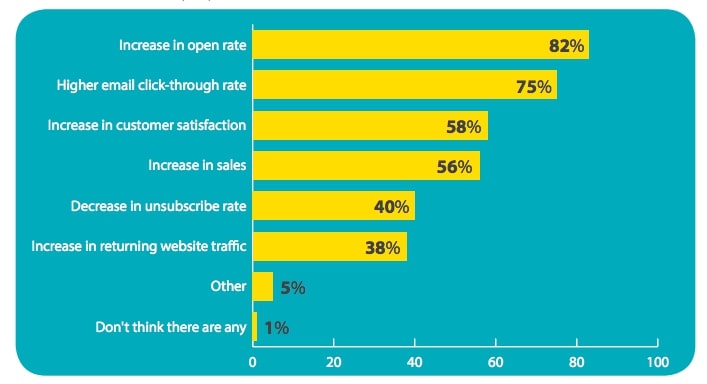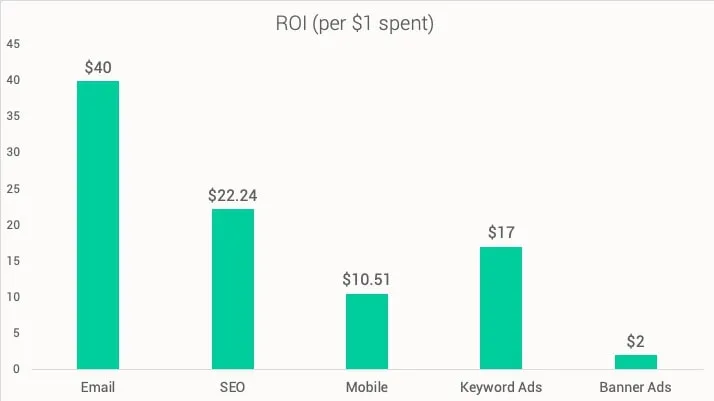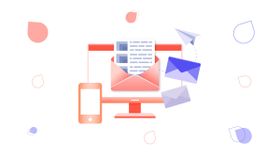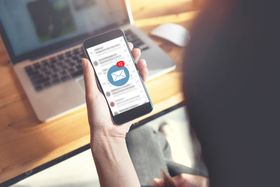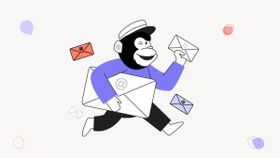Local Email Marketing Tips For Small Businesses
As a small business, local email marketing is key for developing a relationship with potential customers in your community. Get these valuable tips today!
Updated November 6, 2024

More than 80% of all small businesses rely on email marketing as their marketing channel to drive sales and create brand loyalty among their customers. If you're not doing it yet, you're likely leaving money on the table.
Here's the thing: email marketing can be confusing. Between tools, tactics, and strategies, it's easy to get lost in the web of information out there. And with the average office worker receiving 121 emails per day, how do you make sure your email stands out from the rest?
We've put together a guide to help you with your local email marketing. Keep reading if you want to learn more and (finally!) get a grip on how to use email to fuel your small business.
What is local email marketing?
Local email marketing is a low-cost, highly efficient marketing channel local businesses can use to get their message directly to prospects in the surrounding area.
(Source)
Difference between local and traditional email marketing
In essence, local and traditional (non-local) email marketing aren't that different. They both happen online, need email lists, and use email marketing software. However, there are some notable differences to be aware of too:
Local contacts
The first and most important difference is that local email marketing requires a segmented list of contacts geographically close to the business. This allows for targeted and relevant messaging based on location-specific information, such as upcoming events or promotions in the area.
Smaller lists
The second key difference lies in the size of the email lists. With local email marketing, the lists are typically smaller since they're confined to a specific geographic area or community. Businesses targeting a local audience thrive on the quality of relationships rather than the quantity of contacts.
Higher level of personalization
The local nature of this type of marketing allows business owners and email marketers to craft more personalized, direct emails that resonate with recipients, potentially leading to higher engagement rates. Smaller lists also make it easier to manage and track the performance of campaigns, providing valuable data-driven insights for optimizing future marketing strategies.
(Source)
More focus on announcements
Unlike "traditional" email marketing, local emails are more focused on announcements (rather than promotions meant to drive direct sales). Some types of announcements you can incorporate into your local marketing strategy include:
- Monthly changes to the menu
- Events you're organizing
- New products just in
- New wall art
- Collaborations with other local businesses
- Sponsorship or participation in local events
- Seasonal deals or discounts
- Community-related news or updates
- Updates related to business hours or services due to local events or holidays
- Employee spotlight or introduction
- Customer testimonials and reviews
- Information about loyalty programs or customer rewards
What businesses can use local email marketing?
Pretty much every small local business can benefit from using email marketing. Some examples include:
- Bakeries
- Restaurants
- Coffee shops
- Boutiques and retail stores
- Salons and spas
- Gyms and fitness studios
- Local service-based businesses (plumbers, electricians, landscapers, etc.)
Advantages of email marketing
If you're wondering if it's worth investing in local email marketing, the short answer is "yes." Here's why:
Building better customer relationships
Local email marketing is an ideal tool for cultivating stronger customer relationships. Unlike large-scale email campaigns, local email marketing focuses on a smaller audience, allowing businesses to get to know their customers intimately.
When they use personalized content that is relevant to the local community, businesses can demonstrate their understanding of their customers' needs and their commitment to the local region. This generates a deeper connection and trust between the business and the customer.
Also, local email marketing allows businesses to regularly stay in touch with their customers, updating them on the latest news, products, or events. This consistent communication helps keep the business at the top of customers' minds, fostering loyalty and encouraging repeat business.
Driving more sales
Local email marketing is a powerful tool that can significantly boost sales for small businesses. The high level of personalization possible through this approach helps capture the customer's attention and cultivate interest in your offerings. Businesses can pique their customers' curiosity and potentially trigger purchases by providing up-to-date information about new products, services, or upcoming events.
Moreover, local email marketing campaigns can feature special offers, discounts, or loyalty programs, incentivizing customers to make repeat purchases or even bringing in new customers through referrals. In essence, local email marketing drives immediate sales and lays the foundation for a sustainable, long-term customer base by fostering strong relationships built on trust and engagement.
Achieving a higher ROI
Of all digital channels, mail marketing brings one of the highest ROI (return on investment): $36 for every $1 spent. There are several reasons for this:
- It's low-cost. Local email marketing doesn't require a significant financial investment, making it accessible for even the smallest businesses.
- It's highly targeted. By sending emails to a segmented list of contacts, businesses can eliminate wasted spend on disinterested recipients and focus their efforts on those most likely to convert.
- It's trackable. Through email marketing software, businesses can easily track the performance of their campaigns, including open rates, click-through rates, and conversions. This data provides valuable insights for optimizing future marketing strategies.
- It's flexible. Businesses can easily modify and adjust their email marketing strategies to cater to specific goals or events, making it a versatile tool for any business.
(Source)
Bringing more in-store traffic
As mentioned before, most local emails are focused on announcing events and in-store promotions, which can effectively drive more traffic to physical stores. By creating a sense of urgency and exclusivity around these events, businesses can encourage customers to visit the store to take advantage of deals or attend events. This drives sales and creates opportunities for in-person interactions and relationship-building.
Learning more about your customers
Local email marketing provides a unique opportunity for businesses to learn more about their customers. By keeping track of the responses and interaction rates to specific email campaigns, businesses can gain insights into the preferences and buying behaviors of their customers.
This information can be instrumental in shaping future marketing strategies, product development, and service offerings. Additionally, businesses may use surveys or feedback forms within their email campaigns to directly gather customer opinions and suggestions. This two-way communication can help businesses fine-tune their operations to better cater to customer needs, ultimately enhancing customer satisfaction and loyalty.
How to run local email marketing for a small business
Running local email marketing campaigns can be overwhelming, particularly if you're a small business owner with limited time on your hands and a small team. However, it can be quite straightforward once you get everything set up.
Here's where to start:
Choose the right tool
An email marketing tool is an application that enables businesses to plan, execute, and monitor email marketing campaigns. It is an essential tool for small businesses to communicate effectively with their customers or potential customers in an organized, efficient, and scalable manner.
Email marketing tools allow you to:
- Craft professional-looking emails
- Schedule them for optimal times
- Manage your contact lists
- And analyze the effectiveness of your campaigns
- Automate your email campaigns (to save your time and ensure consistency)
Investing in an email marketing tool can be a game-changer for small businesses. With proper utilization, it can help you reach a wider audience, create meaningful engagement, boost conversions, and foster customer loyalty, all of which contribute to your business's growth.
There are many email software options available on the market, so, when searching for the right one, make sure it has the following features:
(Source)
Personalization
Personalization in email marketing refers to the practice of targeting email campaigns to specific individuals by using data and information about the recipient. This technique is vital as it allows businesses to speak directly to the customer's needs and interests, increasing engagement and conversion rates.
Design templates
Design templates in email marketing are pre-formatted layouts that can be used for crafting emails. They are crucial as they save time, ensure consistent branding, and enhance the visual appeal of emails. This increases readability and engagement rates among recipients.
Drag and drop
A drag-and-drop interface in email marketing tools allows users to create and design emails by simply dragging and dropping elements into their layout without coding. This feature is crucial as it simplifies the email creation process, making it accessible even to those with minimal technical skills, and allowing for greater creative freedom and customization.
Custom branding
Custom branding in email marketing allows businesses to include their logo, color scheme, and other brand elements in their emails. This ensures brand consistency across all communications, reinforces brand identity, and enhances recognition and trust among potential customers.
Analytics
Analytics and reporting features will provide you with quantitative data on the performance of your campaigns, including open rates, click-through rates, and conversions. This feature is crucial as it helps businesses understand what works and what doesn't in their approach, enabling them to optimize future campaigns and achieve better results.
A/B testing
A/B testing involves trialing two versions of an email to see which one performs better. It's an essential feature, as it allows businesses to test various elements, such as subject lines or content layout, to optimize email effectiveness and increase conversion rates.
(Source)
Pro tip! When running A/B tests, remember to only test one variable at a time, such as your subject line, content, header image, and so on. If you need help setting up A/B tests that drive relevant insight, hire an email marketing consultant to help you with their experienced input.
Segmentation
Segmentation in email marketing is the practice of dividing your email subscribers into smaller groups, or "segments," based on specific criteria like demographics, buying behavior, or engagement levels. This tactic is crucial as it enables businesses to deliver more personalized and relevant content to their audiences, thereby improving engagement rates and boosting conversions.
Form building
Form building in email marketing refers to the creation of custom forms to capture audience data. It is crucial because it allows businesses to collect valuable information from subscribers, such as their interests and preferences, enabling the delivery of more personalized and targeted email content.
Responsive design/ mobile-friendliness
Around 41% of email recipients open and read their emails on their phones, which means you need to make sure your emails are optimized for mobile devices. Having a responsive design in your email marketing tool is crucial as it ensures that your emails look great and function well on different screens and devices.
(Source)
Create a signup form
Signup forms are how you capture email contact information. You can create them with a form builder (like Typeform, 123FormBuilder, or Google Forms) and embed them on your website, social media platforms, or use them as a link in email signatures. Consider trying different form types (such as pop-ups, embedded forms, and sliders), experimenting with their placement on your site, and optimizing copy to attract more subscribers.
Many email marketing platforms also come with signup form capabilities, making it easy to create and integrate a form with your email database. Some email marketing tools also offer pre-designed templates for signup forms, streamlining the process even further.
Build your email list
Once you have an email tool and a signup form, it's time to grow your email list. Here are some ways you can build a robust and engaged email list:
Online marketing tactics
You can use online marketing tactics like social media and search engine optimization (SEO) to drive traffic to your website or landing page, where you can showcase your email signup form. You can also include links to your form in your social media bio, posts, and stories.
Offline/traditional marketing tactics
Don't neglect traditional marketing tactics, as they can be an effective way to reach people offline and direct them to your online presence. Consider including a link or QR code for your email signup form in business cards, brochures, flyers, and other physical marketing materials.
Also, encourage subscriptions when people are in store, host local events, and take the opportunity to capture email contacts after business transactions. Don't neglect partnering with other businesses to cross-promote each other's email lists; this can be an effective way to reach new audiences.
Segment your list into different groups
Email segmentation is essential because it allows you to personalize your content and deliver relevant, targeted messages to specific groups of subscribers.
(Source)
Here are some common ways you can segment your email list:
By demographics
Segmenting based on demographics allows businesses to target audiences with similar characteristics, such as age, gender, location, income level, and more.
By interests or preferences
Segmenting by interests or preferences involves grouping subscribers based on their hobbies, likes, and dislikes, or specific products or services they have shown an interest in. This enables businesses to deliver highly targeted and relevant content that resonates with each subscriber.
By engagement levels
Segmenting by engagement levels involves dividing your audience into groups based on how frequently they open, click, and interact with your emails. This tactic helps you identify highly engaged subscribers who are more likely to convert and those who may need re-engagement efforts.
Types of emails you can send
There are many types of emails you can send to your subscribers, depending on your business goals and audience. Here are some common types of emails:
Welcome emails
Welcome emails are the first email your subscribers receive after signing up for your email list. They are a great opportunity to introduce yourself, set expectations, and provide value.
Promotional emails
Promotional emails are used to promote products or services, offer discounts or deals, and encourage purchases from subscribers.
Newsletters
Newsletters typically contain curated content such as blog posts, industry news, updates, and tips relevant to your audience. They are a great way to keep subscribers engaged and informed.
Transactional and post-purchase emails
Transactional emails are sent in response to a specific action or transaction made by the subscriber, such as order confirmations, shipping notifications, and account updates. These emails have high open rates and can also be used for personalized cross-selling or upselling opportunities
Re-engagement emails
Re-engagement emails are messages you send to inactive subscribers who haven't opened your emails in a while. Some examples include offering an incentive or asking for feedback to re-engage them and bring them back into the fold.
Special event emails
There are plenty of events your local business can tap into to drive more in-store traffic and sales. BFCM emails (Black Friday and Cyber Monday) are just the tip of the iceberg; you can also send emails for holidays, seasonal sales, and other special events to keep your subscribers engaged and up-to-date. Examples include St. Patrick's emails, Mother's Day emails, and so on.
Choose your email design
There are two main ways to design marketing emails:
- Plain text (HTML-free) emails
- HTML emails with design elements such as images, colors, and formatting.
Both approaches have their pros and cons. For example, plain text emails can feel more personal and less overwhelming to busy inboxes; however, HTML emails allow for more creativity and branding opportunities. Consider testing both formats to see which resonates best with your audience.
Whichever style you choose, make sure your emails are visually appealing, easy to read and navigate, and optimized for mobile devices. Also, keep in mind email design best practices such as using a clear call-to-action (CTA) above the fold (the first part of the email), including alt text for images, and avoiding too much clutter or excessive use of fonts and colors.
Track your results
One of the best parts about local emails is that you can track your results quite easily. Most email marketing tools offer robust analytics and reporting features that allow you to measure key metrics such as open rates, click-through rates, conversions, and more. Use this data to improve your email campaigns and achieve better results constantly.
Some of the email metrics you can measure include:
- Open rate: how many people in your list opened your email
- Click-through rate (CTR): how many people in your list clicked on your email link
- Bounce rate: how many emails were not delivered in a given campaign
- Unsubscribe rate: how many contacts unsubscribed (compared to the total number)
- Conversion rate: how many conversions your emails drove, out of the total number of deliveries
- In-store visits: how many people visited your store/office after reading the email (measured by running quick polls with visitors)
(Source)
Challenges of local email marketing
Local email marketing is a great way to promote your business, but it does come with its own set of challenges. Here are some common challenges you may face when implementing local email marketing:
Building a subscriber list
As a local business, gaining subscribers can be a challenge, especially if you don't have an established online presence or customer base. Consider offering incentives or partnering with other businesses to expand your reach and grow your list.
Delivery issues
Delivery issues in local email marketing often stem from a variety of factors. The most common issue is the presence of poor-quality email addresses in your subscriber list. This can occur due to typographical errors during the subscription process or the use of temporary or fake email addresses.
Another significant factor affecting email deliverability is the sender reputation. If your previous emails have been marked as spam or have had a high bounce rate, Internet Service Providers (ISPs) might block or direct your emails to the spam folder.
Lastly, compliance with email laws and regulations like the CAN-SPAM Act and GDPR is crucial. Non-compliance can lead to emails being filtered out by spam filters, blocking your communication from reaching your subscribers' inboxes. Always ensure that your local email marketing strategy adheres to these regulations and best practices to minimize delivery issues.
Design problems
Design is a crucial aspect of email marketing, and local businesses often face several design-related challenges. One common issue is the lack of consistency in design and branding across different campaigns. Consistent branding, which includes the use of company logos, color schemes, and typography, is vital to make the emails instantly recognizable to subscribers. Also, complex layouts with too many graphics can make an email look cluttered, confusing the reader and distracting them from the primary message or call-to-action.
Another significant problem is the lack of mobile optimization. With increasing numbers of users checking their emails on mobile devices, emails not optimized for mobile can be hard to read and navigate, leading to poor user experience and low engagement rates.
Top 12 local email marketing best practices
Need more tips to guide your local email marketing strategy? Here are 12 best practices that can help you make the most out of your campaigns.
Show expertise
Email is a great channel to show expertise, whether by sharing industry news, tips, tricks, or other relevant information. This can help build trust with your subscribers, establishing you as a reliable source of knowledge in your field.
For instance, if you run a plumbing business, you could use your email marketing to share tips and tricks on maintaining household plumbing systems or common DIY fixes for minor issues. Likewise, if you run a local restaurant, you could share recipes or cooking techniques to give your subscribers a taste of your brand's expertise.
Stay personal
Personalization is key in local email marketing because you're communicating with people in your community. Digital channels can feel cold and distant, and email is a great way to bring that "mom-and-pop business" tone of voice back into your online marketing efforts. Use segmentation, local language, and references to local events to make your emails feel more personal and relatable.
(Not a local business, but a great example of personalization that can be applied to local businesses)
Ask for feedback
Want to grow your small local business? Asking your subscribers for input!
You may not get answers from everyone on your list, but your loyal customers will be more than happy to share their suggestions with you. Also, take complaints as an opportunity to improve, too. Nobody's perfect, but aiming to be better is a great way to keep on growing as a small business.
Localize your subject line
Keep your subject line local with language and references, as it makes people more likely to open your emails. Rainy day? Bring that into your subject line. Local city council running an event? Or maybe the main street was unusually crowded today? Bringing these things into your subject line builds rapport with people, and shows you are genuinely involved in the community.
Leverage user-generated content (UGC)
User-generated content is content created by your customers, such as reviews, social media posts, or images. Incorporating UGC into your email marketing can make your campaigns more authentic and relatable to local subscribers. It also acts as social proof for your business and can help build customer trust and loyalty.
Make it easy for customers to subscribe
If you want to grow your email list, you must ensure it's really easy for people to subscribe. Make your signup form accessible, and don't ask for too much detail. A name and an email address should be more than enough to get started. Also, consider adding a signup option on your website's homepage and social media pages to capture more subscribers.
Stay compliant
It's easy to fall into the trap of thinking you're just a small local business and you don't have to worry about email regulations. However, compliance with laws and regulations like the CAN-SPAM Act and GDPR is crucial for all businesses, regardless of size. Non-compliance can lead to hefty fines and damage to your brand's reputation – not to mention hefty fines if someone decides to file an official complaint.
Run regular promotions
Email marketing is an excellent channel for promoting your products or services. Consider running regular promotions and exclusive discounts for your email subscribers to keep them engaged and returning. You can also use emails to announce new products, services, or special events happening at your business.
Maintain data hygiene
As boring as it may sound, keeping your email list clean and tidy is crucial for the success of your campaigns. Regularly clean up your list by removing inactive or incorrect email addresses, and segment your subscribers based on their engagement levels. This will help improve deliverability and ensure that your messages are reaching the right people at the right time.
Include a clear CTA
This might come without saying, but you'd be surprised how many email campaigns forget to include a clear call-to-action (CTA). Without a CTA, your subscribers won't know what action you want them to take, and your campaign's goals will not be met. Your CTA should stand out, be concise and instructive, and placed in an easily noticeable location within the email.
Always test your emails
Don't rush to click that "send" button before you run a quick test send. Doing this helps ensure that they appear and function correctly on different devices, email clients, and browsers. It's also an excellent way to catch any typos or errors before you send the final version to your entire list.
Stay consistent
... Across the board. Your design, tone of voice, and email recurrence should all be consistent to build a strong brand image and customer trust.
This also applies to the frequency of emails. Don't send too many or too few, as both can negatively impact your engagement rates. Find a balance that works for your business and stick with it consistently.
From agora to inbox: keeping local matters on locals' radars
In Ancient Greece, the agora was the central meeting place where people gathered to exchange news and ideas, as well as conduct business. The issue with using the same news delivery system in the 21st century is that communities are (generally) much larger, and businesses are noisier (and larger in number too).
Your customers' email inboxes can serve a similar purpose – with the added convenience of being able to reach people's attention directly. By creating engaging and personalized email content, you're essentially bringing a mini agora into your subscribers' inboxes. This allows you to keep local matters top-of-mind for your customers and foster a sense of community within your email list.
So, what are you waiting for? Have you started building your local email list yet?
If you need help, let us know. Contact Mayple and we'll match you with an affordable, efficient, vetted email marketing agency to help you get things off the ground. We'll have you working together in less than three days.

